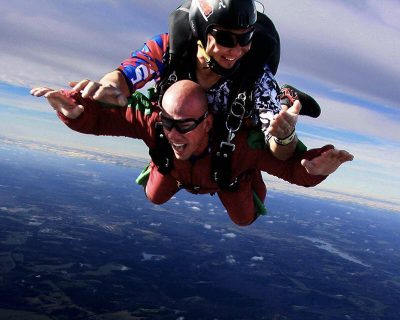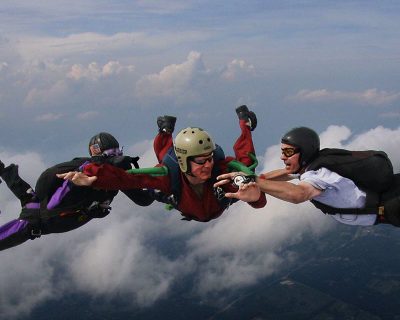Skydiving is a sport that is highly misunderstood because of its uniqueness as well as inaccurate portrayals in the media (especially Hollywood). Don’t get us wrong, it tickles us to see non-skydivers making things up – however, it creates a lot of false information that is far from the truth. So we’re here to bust the skydiving myths and deliver the truth straight from the source at Skydive Monroe!
MYTH #1: Skydiving Is Extremely Dangerous
If you tell someone you’re going skydiving, there’s a pretty good chance that the next words you’ll hear is “you’re crazy” or “oh my gosh, skydiving is so dangerous!” Would you believe us if we told you that tandem skydiving is actually less risky than driving in your car? Or that you’re more likely to die from a dog attack, wasp sting, or choking? Yep. All true.
What is the failure rate of skydiving?
According to the USPA (United States Parachute Association), the calculated rate of skydiving fatalities is 0.28 per 100,000 jumps overall. Tandem skydiving has an even better safety rate of 1 fatality in 500,000 jumps over a 10-year average. What’s more, 2021 went on record as the safest year in skydiving history, with 0 student fatalities and 10 deaths in 3.57 million jumps. Most skydiving-related fatalities are attributed to licensed skydivers attempting high-risk parachute maneuvers, like intentional low turns too close to the ground, or due to some unforeseen medical issue.
 MYTH #2: You Go Up When the Parachute Opens
MYTH #2: You Go Up When the Parachute Opens
This popular myth was likely created by curious first-timers watching skydiving videos. If you’re watching a skydiving video from the perspective of the outside videographer, it almost seems as though the tandem skydivers go UP when the instructor pulls the parachute. The truth is, it’s all an illusion. It seems this way because the videographer is still descending at their terminal velocity, while the tandem skydivers are slowing down their fall rate. You go from a fall rate of 120 mph to an average descent rate of about 15 mph, which is why it looks like you go “up” from the perspective of the freefalling skydiver below. So basically, they’re just falling faster than you!
MYTH #3: You Feel Like You’re Falling
We hear it all the time, “I hate rollercoasters, so I’ll never go skydiving!” Well, we’re here to tell you that skydiving is not at all a rollercoaster ride, and you won’t get that falling sensation. It’s hard to believe that you won’t feel like you’re falling, since you are literally falling through the sky.
Does your stomach flip when you skydive?
Nope. You won’t get that stomach drop sensation because you won’t be going from 0 to 120 mph. The aircraft is already moving at speeds around 100 mph – so when you jump out, you’re only increasing your speed by about 20 mph. Once you “ride the hill” and reach your terminal velocity, you’ll stabilize and feel like you’re getting a big hug from the sky and lots of tiny air molecules rather than falling and flailing.
 MYTH #4: You Can’t Breathe In Freefall
MYTH #4: You Can’t Breathe In Freefall
Many first-time jumpers believe that it is hard to breathe while skydiving, but this is all due to the dive reflex, or mammalian reflex, that occurs when we jump in cold water. It is actually a survival instinct to hold your breath for a moment when there is a large gust of wind in your face. We believe this could be the reason why some people feel like they can’t breathe in freefall, but we don’t know for sure. If you have asthma or other breathing concerns please consult with a physician before making a skydive.
If this happens to you, try focusing on making nice controlled breaths – in through the nose and out through the mouth. Another tip is to let out your best roar as you exit the plane to help jumpstart the breathing process.
MYTH #5: You Can Talk While Skydiving
Thanks to Hollywood, some people have the wrong impression that we can talk in freefall. Okay, so maybe you can (technically) talk while skydiving … but nobody is going to HEAR you. Skydiving can get pretty loud, especially during freefall with 120 mph winds rushing all around you – you’ll barely be able to hear a thing. To put it in perspective, a normal conversation is at about 60 dBA and the noise level in freefall is around 115 dBA. This is why skydivers came up with special hand signals in order to communicate in freefall
Don’t worry, after having the rush of a lifetime, you’ll be able to describe your amazing story to your instructor while floating blissfully (and super quietly) on your canopy ride back down to the ground.
Put these skydiving myths to the test, come see for yourself and book a skydive with Georgia’s #1 Skydiving Center – Skydive Monroe! Blue skies, y’all!
Copyright © 2024, Skydive Monroe, All Rights Reserved.
DropZone Web Design & Marketing by Beyond Marketing, LLC



